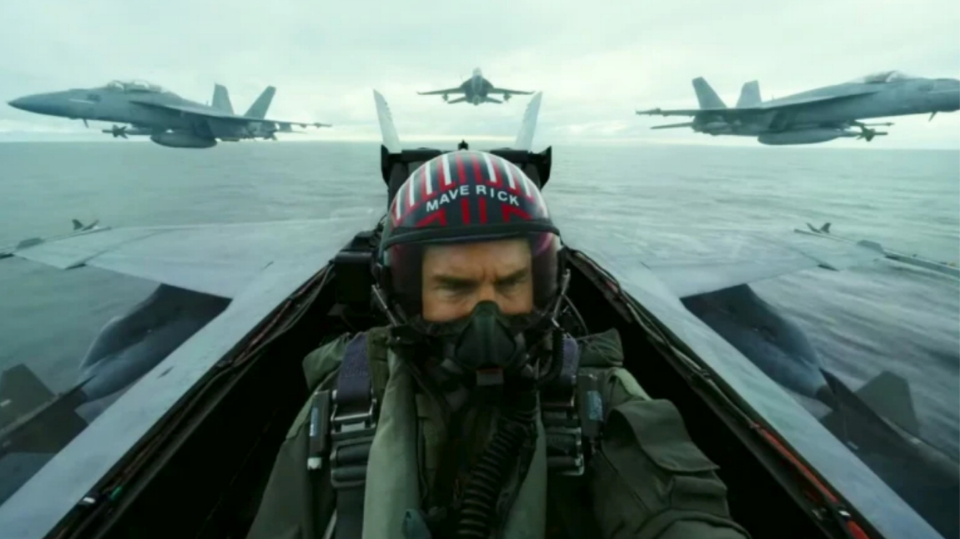
Top Gun: Maverick is part of the tradition of legacy sequels for properties from the 1980s that we’ve been seeing for the last decade-plus. Rocky extended through three decades before giving way to the Creed movies. Eleven years after the Star Wars prequels ended, the sequel trilogy picked up the narrative 35 years after the original trilogy left off. Blade Runner got an excellent sequel 35 years on. Willow is getting a TV series; He-Man just got two on Netflix.
So the moviegoing public is by now used to seeing actors reprise roles they haven’t played in decades, with new crews and supporting casts reprising old themes in familiar plots. Maverick is no Blade Runner 2049 but it’s better than The Force Awakens.
- It’s a ham and cheese sandwich of a film—earnest and committed to what the skeptic might consider silly.
- It’s a U.S. military propaganda film which is intended to drive Naval recruitment in the same way its predecessor did, setting up booths outside of screenings while the Navy suffers historic numbers of desertions and suicides.
- It’s a movie about the importance of America’s weapons and the men and women who wield them with the alleged duty to keep the world safe for freedom. There is no engagement with issues of class or race, though gender is utilized to demonstrate the closed-minded cocksure Neanderthal-bully nature of one character. It has no sort of revolutionary or reformative intent.
- It’s a hoorah movie. And it’s also a damned good time.
The plot is straightforward. Former fighter pilot-turned-test pilot for the U.S. Navy, Pete Mitchell, callsign Maverick (Tom Cruise), is moved from his job testing experimental aircraft to train an elite team of Navy pilots to destroy a nuclear weapons facility in the mountains of some unnamed enemy in Eurasia. Among his Top Gun trainees is the son of his dead wingman, Nick “Goose” Bradshaw, from the last movie. Goose’s son, Bradley Bradshaw, callsign Rooster (Miles Teller), has a grudge against Maverick. At first, we think it’s just because his dad died flying with Maverick, though we later realize it’s because Maverick delayed Rooster’s entry to the Annapolis Naval Academy at Rooster’s late mother’s request. They bury the hatchet between them on the dangerous mission into the unnamed enemy’s territory. The bully saves their lives after they save one another’s. Joy erupts when they get back to the aircraft carrier. Lady Gaga starts singing when Cruise’s film-long love interest Penny (Jennifer Connelly) shows up while Maverick and Rooster are bonding as they work on an airplane together, then Tom Cruise takes Connelly into the air as the credits roll.
There are parallel dynamics to the original film, though romance is handled differently, and Maverick gets to do a little bit of the Stand and Deliver/Lean On Me thing—except instead of being a minority trying to reach inner-city kids he’s an elite pilot working to train other elite pilots.
The real strength of the film is, unsurprisingly, in the action—the aerial stunts, the real aircraft flight used to make the movie, and the performances and technical effects that sell the immersive experience of being in a fighter jet flying hundreds of miles per hour through the air, banking and weaving through hills and deserts or forested mountain ranges, dodging surface-to-air missiles and dogfighting with enemy jets. It’s an incredibly captivating spectacle that showcases the marvels of cinema and flight and the intense experience of combat training and combat missions. It’s truly gripping. It holds onto you in the moment and doesn’t let go.
Not without its problems
But the film is not without its problems. While I respect Tom Cruise’s commitment to endangering himself to entertain me, I would have liked it if he were just a little bit less the star in this one. The younger actors were compelling and I wish I got more of their interiority.
I also appreciated his romance with Jennifer Connelly’s character, Penny. It felt, well, adult. Still Hollywood, but not overly starry-eyed. However, it also contributed to the feeling of the film as being the third part of a trilogy that was missing a middle. The events of the first film were referenced at a rate and in a manner which allowed someone who’s never seen that movie to get this one, and for someone who’s seen the original to reflect fondly. But intervening events were alluded to in a way that made me wonder if there were fill-in comics or something I should own.
I can forgive the movie this because it might be less the film’s structure and more the perversion of my expectations about big-budget action movie storytelling influenced by the proliferation of the four-quadrant picture—or because my film tastes were formed by Star Wars and Back to the Future; you can blame Disney today or the movies of yesteryear. I’m saying I had to check IMDb to make sure she wasn’t in the original. It’s perfectly natural for film or TV or book protagonists to have lives we’re not privy to, but it’s just increasingly uncommon.
One reflection I had late in the film is that aviation is a true wonder. It pains me, though, how many innovations only happen in service to violence done in the names of capital and empire. The film takes for granted, and likely much of the audience will as well, that the U.S. intel on nuclear weapon proliferation is good, even though in my living memory we’ve committed thousands of troops, killing and displacing millions of Afghan and Iraqi citizens on lies about weapons of mass destruction. Moreover, the film can’t ask, but I hope the audience does, why Iran or any other country might feel a need to develop nuclear weapons.
My working hypothesis is that the country with the largest standing military in recorded history has hundreds of bases across the globe and unilaterally determines the rules of a so-called “rules-based” unipolar order, arbitrarily sanctions its undeclared enemies, and routinely fosters regime change in other countries.
I believe nuclear weapons are a net negative. But it should come as little surprise that so many countries that have borne the brunt of 19th- and 20th-century imperialism and 20th- and 21st-century neocolonialism feel a need to put in place failsafes to defend their sovereignty. No one in the film doubts the necessity of the mission; this isn’t that kind of war movie. The fact that it’s a hostile act on foreign soil without a thought given to any sort of Congressional declaration of war is just accepted. The mission is completed and the good guys policing the world go home to their families.
No thought is given to the scientists in the alleged nuke facility. Nor to the janitors. Nor to their families and communities. They simply made the mistake of being born in the wrong country. The enemy pilots, whose deaths are nothing but a tally for our heroes to mark their own ability, are dehumanized. Unlike Maverick, Rooster, Bob (Lewis Pullman), Phoenix (Monica Barbaro), Hangman (Glen Powell), Payback (Jay Ellis), or Fanboy (Danny Ramirez), their faces are completely covered, no sound comes from their mouths, the heroes don’t understand their sign language. They’re just “bandits,” targets, enemies.
It’s a very well-made propaganda film that’s held up rather than held back by its nostalgia for the Cold War-era Top Gun. From the text on screen at the beginning to the interpolation of Haltemeyer’s 1986 score in this composer Lorne Balfe’s, to the way the credits roll, it’s a movie that reminds its audience, repeatedly, that they’re there because its predecessor was iconic entertainment.
I had a great time with Top Gun: Maverick. I had the peculiar sensation of experiencing nostalgia for a movie that came out eight years before I was born. I saw beautiful people party in their polished uniforms before flying expensive jets to blow up America’s enemies. I heard Lady Gaga sing “take my hand” as Jennifer Connelly and Tom Cruise held hands. I ever so briefly heard Kenny Loggins sing “Danger Zone.” I also have a dear attachment to Val Kilmer that was born in Batman Forever and which continued through Heat and Kiss, Kiss, Bang, Bang. Regardless, it truly warmed my heart to see Admiral Iceman. The character, like Kilmer in real life, suffered throat cancer, and the brief utilization of his voice came from AI reconstruction because Kilmer can no longer speak.
Joseph Kosinski directed the script by Jim Cash and Jack Epps Jr. based on characters in the earlier film.
Top Gun: Maverick is kind of great. You just have to remember what you’re in for: nostalgia and propaganda.












Comments